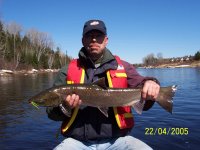The Danville Chenille Company - A New Hampshire Tradition
The Danville Chenille Company - A New Hampshire Tradition
by: Bill Thompson
It is a good bet that most fly tiers would agree that one of the most important ingredients in any fly would have to be the thread. Given the wide variety of different threads available to tiers today, it is hard to imagine a time when good thread was hard to find. There was a time when fly tiers relied on common sewing thread to tie their flies. If you have ever experimented with a spool of thread from your wife's sewing basket you know what these tiers were up against.
Sometime in the late 1940s, a fellow by the name of Herm Meyer was frustrated by the lack of quality fly-tying thread. As you might have guessed, he was an avid fly fisherman and fly tier. Mr. Meyer was a true New Hampshire Yankee and set out to remedy the problem. The problem was to come up with a thread that was both strong and would lay flat on the hook.Meyer began to experiment and came up with the first pre-waxed thread, the prototype of today's Danville Fly Master Plus tying thread. As a result, the Danville Chenille Co. came into existence. In addition to threads, the new company also manufactured chenille and sold a selection of other fly-tying materials. The sole purpose of the company was to manufacture and sell products exclusively for the fly tying trade.
Not long after the company came into being, a young man by the name of Raymond Merrick began to work there. Merrick was just 16 when he started. Over the years, he became more and more involved in the operation. Eventually in 1980, he came to own the company. Today, the company is owned by Laura Farley, Merrick's daughter, and her brother-in-law, Dan Bezanson.
Some time ago, I visited the company's headquarters and manufacturing plant, located in a lovely old brick building right on Route 111 in Danville, and had the opportunity to talk with Farley and Bezanson about the history of the company. Farley told me that the earliest paper work. still in existence, dates back to around 1951.
Farley told me that she began working in the factory along with her sister when she was in high school. She said that unfortunately, over time, a lot of memorabilia was no doubt thrown out, and not a lot of the company's early history is known. Laura mentioned that our conversation had inspired her to delve deeper into the archives before any more of the company's history disappeared.
Meyer was able to purchase some of the thread making machinery from a company in upstate New York. Today, the same machines are still in use — some of them a hundred years old. Bezanson told me how in the early days the thread was run through heated frying pans of hot wax to create the waxed thread.
Today, there are three special built machines that do the job, but those machines were not built yesterday. Not a single machine in the factory is computer operated. Some of the larger machines are still belt driven. As you might expect, new parts are an issue. Today, when a replacement part is needed a machinist must be called upon to make one. Fortunately, these machines were made in an era when things were built to last.
Myer was somewhat of a pioneer when it came to experimenting with new materials as well. He was perhaps the first to introduce nylon thread to the fly-tying community.
Of course, as the name of the company suggests, they also make chenille. Danville makes three different varieties of chenille: rayon, nylon and crystal. There are 41 different colors available in the rayon alone. The day I was there, two employees were engaged in making chenille. Each machine was manned by a single operator. The material is strung out across the shop's floor much like a rope factory.
Floss is another important product of the company. Originally silk was the only material that floss was made with. Because of the expense, rayon was substituted. Like the chenille, the floss comes in dozens of colors.
Danville also makes stretch floss. This stuff is great for tying tags on Atlantic Salmon flies, however, I have found when it comes to tying bodies for Humpies, this stuff is the greatest. Another great product is the rayon wool. It comes in an array of florescent colors and makes supper streamer bodies.
When the company is running at full strength they employ as many as fifteen workers, however at present they have seven. Laura and Dan explained that business had been declining in the last few years. I asked if imports had been a problem and thankfully they had not.
Farley showed me a sample of Chinese made chenille, made for the craft trade. It fell apart in her hands. I personally don't think the industry is going away any time soon, but it does seem that less fly fishermen are tying their own flies these days. It's a shame if this is true. One of the great joys of fly fishing is the experience of catching a fish on a fly you have tied yourself.
With so much of American industry relocating overseas, it is nice to know that one of the stalwarts of the fly fishing/tying industry is located right here in New Hampshire. For many years the Danville Chenille Co. has been producing the industry's standard of excellence in thread and chenille. Bezanson and Farley are to be congratulated for their service to the fly-fishing community. Small companies like Danville are the backbone of the fly-fishing industry.
See you on the river.




What's Related